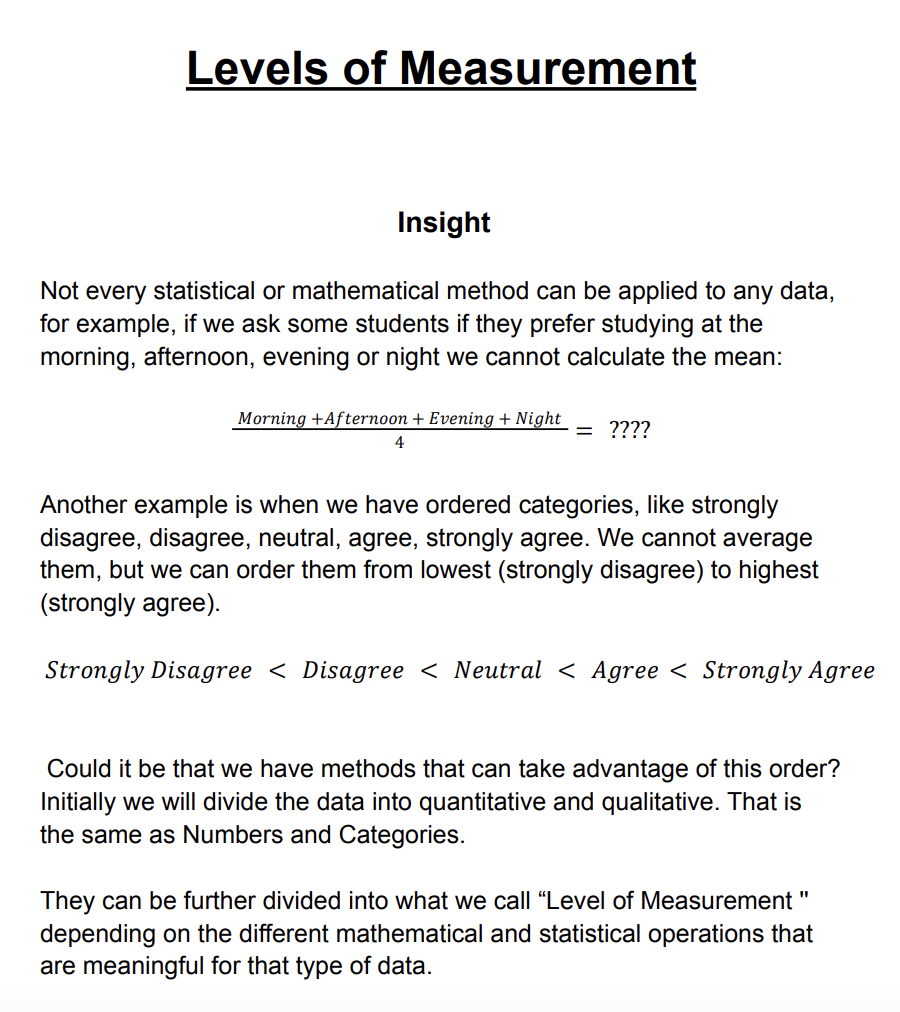Levels of Measurement in Data Analysis
Summary:
This text discusses levels of measurement in data analysis. It explains the distinction between qualitative (categorical) and quantitative (numerical) data and the four levels of measurement: nominal, ordinal, interval, and ratio. Nominal scale refers to basic labelling without inherent order, while ordinal scale involves ordered categories. Interval scale deals with numerical data where the distance between values is meaningful, and ratio scale includes a true zero point. The text also highlights exceptions and provides a cheat sheet for understanding the levels of measurement. Additionally, it offers practice exercises to classify variables and assess comprehension.
Excerpt:
Levels of Measurement in Data Analysis
Levels of Measurement
Insight
Not every statistical or mathematical method can be applied to any data. For example, if we ask some students if they prefer studying in the morning, afternoon, evening or night we cannot calculate the mean:
Levels of Measurement in Data Analysis
Another example is when we have ordered categories like strongly disagree, disagree, neutral, agree, and strongly agree. We cannot average them, but we can order them from lowest (strongly disagree) to highest (strongly agree).
𝑆𝑡𝑟𝑜𝑛𝑔𝑙𝑦 𝐷𝑖𝑠𝑎𝑔𝑟𝑒𝑒 < 𝐷𝑖𝑠𝑎𝑔𝑟𝑒𝑒 < 𝑁𝑒𝑢𝑡𝑟𝑎𝑙 < 𝐴𝑔𝑟𝑒𝑒 < 𝑆𝑡𝑟𝑜𝑛𝑔𝑙𝑦 𝐴𝑔𝑟𝑒𝑒
Could we have methods that can take advantage of this order? Initially, we will divide the data into quantitative and qualitative. That is the same as Numbers and Categories.
They can be further divided into “Level of Measurement ” depending on the different mathematical and statistical operations that are meaningful for that data type.
Type of data: Quantitative vs Qualitative First, we need to distinguish between two main types of data: the qualitative, which consists of categories. Here the data are labels or attributes, for example, the colour of a car (red, blue, white, etc.), feelings (happy, angry, sad, etc.), type of building (house, department, mansion, etc.), grades (A, B, C, D or F) or country (USA, Canada, Mexico, Argentina, Spain, etc.).
On the other hand, we have the quantitative data and the numerical data. It is the data we get when we measure or count something: Blood pressure, Money in the bank account, temperature, height, grade ( 1 to 100), etc.


Reviews